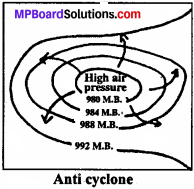MP Board Class 7th Social Science Solutions Chapter 10 Air Pressure and Wind
MP Board Class 7th Social Science Chapter 10 Text Book Questions
Choose the correct alternatives:
Mp Board Class 7th Social Science Chapter 10 Question 1.
The unit of measuring air pressure is:
(a) Millimeter
(b) Millibar
(c) Milligram
(d) Centimeter.
Answer:
(b) Millibar
Class 7th Social Science Chapter 10 MP Board Question 2.
The hot winds which blows during the summer season in Northern India is called:
(a) sea-breeze
(b) Loe
(c) land breeze
(d) trade winds.
Answer:
(b) Loe
Class 7 Social Science Chapter 10 MP Board Question 3.
The example of seasonal winds is:
(a) Land breeze
(b) Westerly
(c) Polar winds
(d) Monsoon.
Answer:
(d) Monsoon.
Fill in the blanks:
- The instrument used to measure air pressure is called …………..
- The air pressure is ………….. over the surface of sea.
- The sea breeze blows from ………….. to …………
- The wind, which blows in a particular region, is called ………….. winds.
Answer:
- barometer
- highest
- sea, land
- local.
MP Board Class 7th Social Science Chapter 10 Short Answer Type Questions
Class 7 Social Science Chapter 10 Question Answer MP Board Question 1.
What is a Barometer used for?
Answer:
A Barometer is used for measuring die pressure of the air.
Mp Board Class 7 Social Science Chapter 10 Question 2.
Write the two factors affecting air pressure.
Answer:
- The two factors affecting air pressure
- Height from the sea level.
- Temperature.
Social Science Class 7 Chapter 10 MP Board Question 3.
Name the types of permanent winds.
Answer:
The types of permanent winds:
- Trade winds
- Westerlies
- Polar winds.
Mp Board Class 7 Science Chapter 10 Question 4.
What do you mean by monsoon winds?
Answer:
The moist air that blows during specific seasons is known as monsoon winds.
Class 7 Science Chapter 10 MP Board Question 5.
What is Farrell’s law?
Answer:
Ferrel’s Law – A scientist named Ferrel had proved that ‘Due to earth’s rotation, winds and oceanic currents turn towards right in the northern hemisphere and towards left in the southern hemisphere.
MP Board Class 7th Social Science Chapter 10 Long Answer Type Questions
Question 1.
What are winds? Differentiate between air and wind.
Answer:
Winds are the natural horizontal movement of air over the earth’s surface.
Difference between air and wind:
- When air moves vertically downwards or upwards, it is known as air. But when it moves horizontally, it is known as wind.
- Airis calm-but when it becomes dynamic it take/the form of wind. Wind always blows from high pressure to low pressure.
Question 2.
What is air pressure? Draw a labeled diagram of air pressure belts.
Answer:
Atmospheric pressure is die pressure of a vertical air column of a unit area on the earth surface. It is the air pressure. The atmospheric pressure is measured in Millibar. The pressure of the air is measured by an instrument called Barometer.
Labeled Diagram of Air Pressure Belts:

Question 3.
Describe the air pressure belts with the help of a diagram.
Answer:
The atmospheric pressure is not die same at all places on the earth’s surface. Generally, air pressure is classified into
- High pressure
- Low pressure.
The air pressure is more when the air is cold whole it is less when the air is hot The four pressure belts of the earth are given below:
- Equatorial Low – 0° .to 10° in the North Pressure belt and South.
- Sub – tropical – 30° to 35° in the North High Pressure and South. belts.
- Sub Polar Low – 45° to 66\(\frac { 1 }{2 }\) in the North Pressure belt and South.
- Polar High – 85° to 90° in the North Pressure belt and South.

Question 4.
What are cyclones and anti-cyclones? Explain with illustrations.
Answer:
Cyclone – A cyclone represents an area in which the low pressure is developed at the center and the same is surrounded by higher pressure outide. It often brings thundering, clouds and rain.
Anti Cyclone – Anti cyclone presents an area in which the light pressure is developed inside and the same is surrounded by low pressure outside. These winds bring no rain. The sky remains clear.
Illustrations:


Question 5.
Describe the sea breeze and land breeze.
Answer:
Sea breeze:
During the day the land surface is quickly heated up while the water is relatively cool. The air over land gets heated, it becomes lighter so it rises up. It moves to fill the empty space. This movement of air is from sea to land so the wind is called sea breeze.

Sea breeze:
Land breeze – The land heats up faster and also cools down faster than the water. During the night, land becomes cool while the water remains comparatively hot. The hot air become light and starts rising. The cool breeze blowing from land fills up this empty space. As these winds blow from land to sea, they are known as land breeze.
